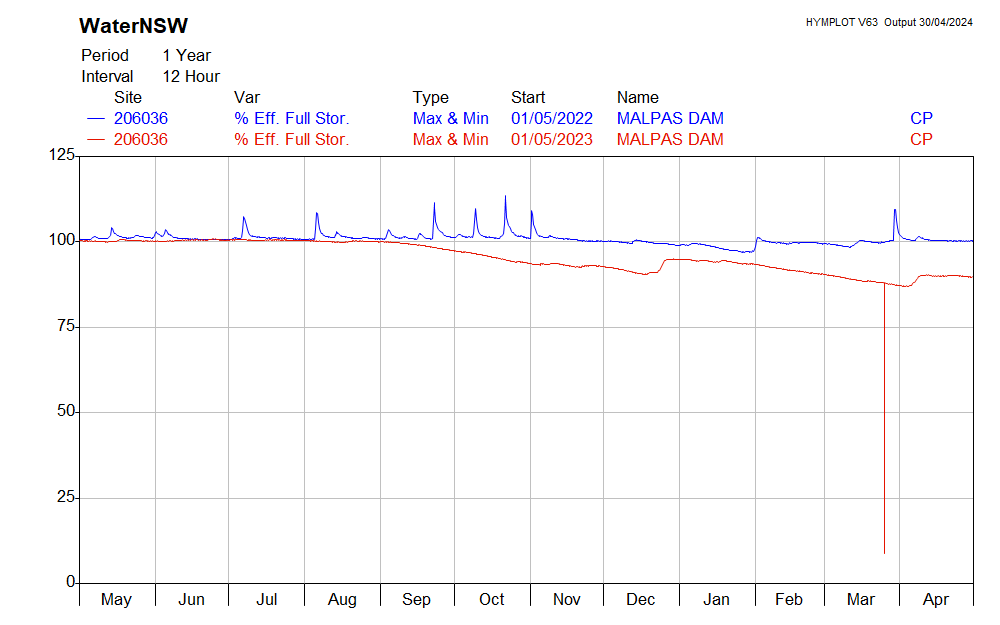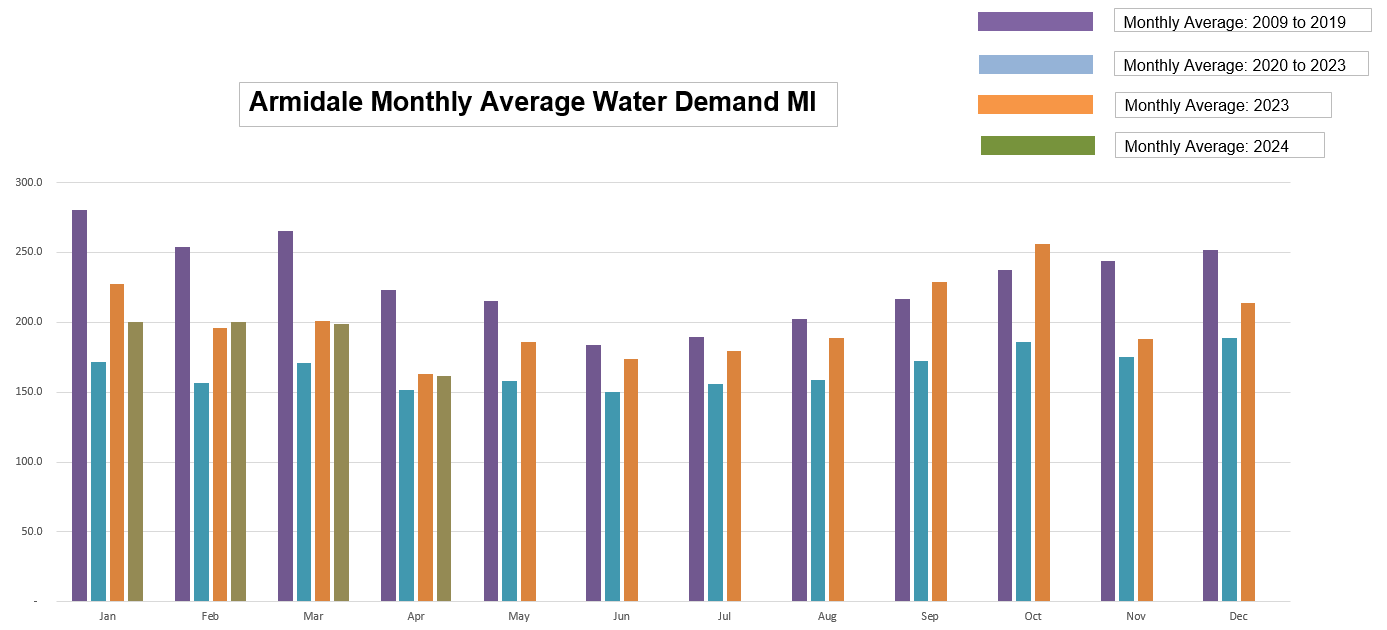Dam levels as at Monday 29 April 2024.
Armidale region total water storage: 90.4%
Treated water usage: 42.621ML million litres of the week ending 28 April 2024.
Plant Run Hours: 68 hours
Malpas Dam storage in the last two years is as below (source Water NSW real time data)
Council water production
Malpas Dam: 89.5%
Guyra Dam: 100.4%
Puddledock Dam: 100%
Dumaresq Dam: 85%


Armidale Water Supply
Malpas Dam is located to the south east of Guyra and to the north of Armidale. It was built as the major water supply for the city of Armidale. Its construction was completed in 1968 and currently has a storage capacity of 13,000 million litres with expansion capabilities to 26,000 million litres.
Puddledock Dam was designed and constructed in 1928 by the Public Works Department as the water supply for Armidale city and the surrounding area. Following the completion of Malpas Dam in 1968, Puddledock Dam was taken out of service and is now used as an emergency water supply only.
Raw Water Users
Malpas pipeline: Blue Green Algae - Nil Alert
Puddledock pipeline: Blue Green Algae - AMBER Alert
Recreational Water Users
Dumaresq Dam: Blue-Green Algae - Nil Alert
Dumaresq Dam open to day visits only and closed completely from 30 January 2023 for upgrades.
Malpas Dam: Blue-Green Algae - Green Alert
Guyra water supply
Guyra's water supply system extracts water from the Gara River system with two dams located on the river north of Guyra. The first dam was constructed in 1957, with a second dam added in 1967 to supplement the supply storage. Water is pumped to the Council’s water treatment plant and then the treated water is pumped to the two town reservoirs. The pump line to the treatment works had augmentation works completed in 1981 with the addition of the second larger town reservoir to meet the town requirements at that time. Council has made improvements to the water system in Guyra with the implementation of fluoridation of the Guyra water supply. The fluoridation dosing equipment was installed in 2008. Other improvements included the relocation of the activated carbon dosage plant to the water supply reservoirs to improve the quality of the taste and odour of the water.
Guyra Dam: Blue Green Algae - RED Alert
Drinking water quality
Some algae can produce taste, odour and toxic compounds. Blue-green algae are naturally occurring organisms that live in rivers, lakes and waterways. Favourable environmental conditions such as warm water temperatures, sunny days and increased nutrient levels can cause algal blooms. ARC has treatment barriers and processes in place to remove algae cells and chemical compounds.
The safety of the Armidale region’s drinking water is confirmed through an extensive testing and monitoring program that aligns with Australian Drinking Water Guidelines 2011 (the ADWG), which are endorsed by the National Health and Medical Research Council.
Armidale Regional Council has 26 sampling locations throughout our drinking water network in Armidale and Guyra. Samples from these locations and the water treatment plants are used to conduct more than 25,000 tests each year.
We conduct daily operational testing and continuous online monitoring at our water treatment plants, reservoirs and dams.
Additional samples from the 26 locations are sent to a National Association of Testing Authorities (NATA) laboratory for independent testing. ARC achieves 100% compliance with all health-related water quality criteria in the ADWG.
Water sample from various locations is tested regularly by independent NATA accredited laboratory, which includes testing for lead. In Australia and across the world, lead is still used in the manufacture of a range of plumbing products, such as brass fittings that may come in contact with water in customers’ homes. Lead can dissolve into drinking water from some brass plumbing fittings, particularly where water has been sitting for extended periods. More information on lead can be found on the NSW Health website.
Yes. In NSW, fluoridation of public water supplies is authorised and controlled by the Fluoridation of Public Water Supplies Act 1957 and the Fluoridation of Public Water Supplies Regulation 2002 and is administered by the NSW Department of Health. The Minister’s approval or direction is required to add fluoride to a public water supply or to discontinue the application.
(500 to 5,000 cells/mL)Blue-green algae occur naturally at low numbers. At these concentrations, algae would not normally be visible, however some species may affect taste and odour of water even at low numbers. Does not pose any problems for recreational, stock or household use.
Note: These alert levels represent the current 'bloom' conditions within the dam/reserve and not the final treated water quality.
(50,000 or over cells/mL)These alert levels represent 'bloom' conditions. Water will appear green or discoloured and clumps or scums could be visible. It can also give off a strong musty or organic odour. Algae may be toxic to humans and animals. Contact with or use of water from red alert areas should be avoided due to the risk of eye and skin irritation. Drinking untreated or boiled water from these supplies can cause stomach upsets. Alternative water supplies should be sought or activated carbon treatment employed to remove toxins. People should not fish when an algal scum is present. Owners should keep dogs away from high alert areas and provide alternative watering points for stock.
Note: These alert levels represent the current 'bloom' conditions within the dam/reserve and not the final treated water quality.
(5,000 to 50,000 cells/mL)Blue-green algae may be multiplying and the water may have a green tinge and musty or organic taste and odour. The water should be considered as unsuitable for potable use and alternative supplies or prior treatment of raw water for domestic purposes should be considered. The water may also be unsuitable for stock watering. Generally suitable for water sports, however people are advised to exercise caution in these areas, as blue-green algal concentrations can rise to red alert levels quickly under warm, calm weather conditions.
Note: These alert levels represent the current 'bloom' conditions within the dam/reserve and not the final treated water quality.
Council monitors and tests the town water supplies for microorganisms and chemicals that are harmful to human health. It also tests for issues that can affect the water’s taste and odour.
Some water quality parameters are monitored continuously through online analysers at the water treatment plant. Samples are taken in the raw water, within the treatment plant, at the outlet of water treatment plant, in the distribution network, at the reservoirs and from customers’ taps.
In addition, samples are sent to external laboratories for independent testing on a weekly, monthly or annual basis, with different frequencies for specific tests, in line with health regulations.
Safe drinking water is treated water that is free of harmful concentration of chemicals or pathogenic microorganisms and that does not represent any significant risk to health over a lifetime of consumption.
Water ‘hardness’ is a measurement of the amount of dissolved calcium and magnesium in water.
Drinking water supplied by Armidale Regional Council has an average water hardness of 120 mg/L (as CaCO3), which rates as good quality under Australian Drinking Water Guidelines. ADWG guidelines for water hardness:
|
<60 mg/L
|
Soft but possibly corrosive
|
|
60 – 200 mg/L
|
Good quality
|
|
200 – 500 mg/L
|
Increasing scaling problems
|
|
>500 mg/L
|
Severe scaling
|
Water can become discolour for a number of reasons, including sediments at dead ends of the reticulation system and disturbance of sediments within water mains because of main breaks. Council’s distribution systems are flushed routinely as part of our preventative maintenance program. Discoloured water can also arise due to the condition of private service pipes or internal plumbing. If your water is dirty, we suggest that you run at least two taps for few minutes until water is clear. If the water does not clear up within a reasonable period of time, we suggest you call Council on 1300 136 833 for assistance.
The majority of routine testing is done by our qualified water treatment plant operators at an in-house laboratory. Samples from various locations are also sent to an independent NATA accredited laboratory weekly and monthly for microbiological and chemical testing.
Chlorine is added to drinking water to kill disease-causing pathogens such as bacteria, viruses and protozoans. The Australian Drinking Water Guidelines 2011 (ADWG) recommend the level of free chlorine in a drinking water should be between 0.5 mg/L to 5 mg/L. Normal chlorine concentration in drinking water pipelines is between 0.5 mg/L to 1.5 mg/L. The chlorine residual within the supply can dissipate over time and distance. To maintain some chlorine at the extremities of the reticulation system and prevent possible coliform regrowth and maintain minimum chlorine level of 0.5 mg/L, the dosage at the treatment plant is often increased. This means residents near a water treatment plant might notice the taste and smell of chlorine in drinking water - but it is still safe to drink. Chlorine odour can be reduced further by letting the water sit in the fridge in an open jug for a short period before consumption or using a filter containing an activated carbon filter cartridge.
A milky or white appearance may indicate the presence of air in your water. The air is harmless and will usually settle out if left to stand in a jug or container. We suggest you run at least two taps for few minutes until water is clear. If the water does not clear up with in a reasonable amount of time, we suggest you call Council on 1300 136 833 for assistance.